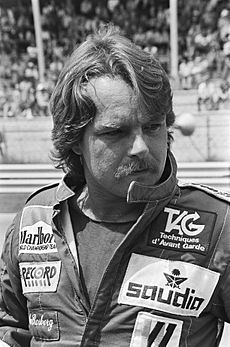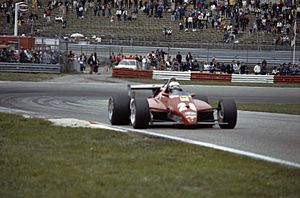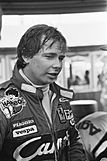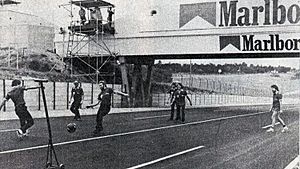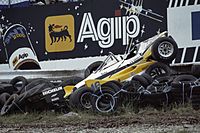1982 Formula One World Championship facts for kids
| 1982 FIA Formula One World Championship |
|||
| Drivers' Champion: Keke Rosberg Constructors' Champion: Ferrari |
|||
| Previous: | 1981 | Next: | 1983 |
The 1982 FIA Formula One World Championship was a thrilling season of Formula One motor racing. It was the 36th time this championship was held. Two main titles were up for grabs: the Drivers' Championship for individual racers and the Constructors' Championship for the teams.
This season had sixteen races from January to September. Keke Rosberg became the Drivers' Champion. His team, Ferrari, won the Constructors' Championship.
The 1982 season started with a drivers' strike. There was also a partial race boycott at the San Marino Grand Prix. This was part of a big disagreement called the FISA–FOCA war. Keke Rosberg won the Drivers' Championship even though he only won one race, the Swiss Grand Prix. He was very consistent, finishing well in many races. He ended up five points ahead of Didier Pironi and John Watson.
It was a unique year because eleven different drivers won races. No driver won more than twice! There was even a streak of nine different winners in nine races. Ferrari won the Constructors' Championship. They replaced some drivers during the season. Patrick Tambay joined after Gilles Villeneuve's accident. Mario Andretti also raced for them later. Ferrari finished just five points ahead of McLaren, with Renault in third place.
Sadly, 1982 was a very difficult year. Two drivers lost their lives: Gilles Villeneuve during qualifying for the Belgian Grand Prix, and Riccardo Paletti at the start of the Canadian Grand Prix. Didier Pironi, who was leading the championship, had a terrible accident. This happened during qualifying for the German Grand Prix. His injuries were so severe he could not race again. These sad events led to new rules for the 1983 season. These rules aimed to make racing much safer.
The 1982 season marked the end of an era. Before this, it was common for one or two F1 drivers to die each year. After 1982, only four drivers have died in Grand Prix events or tests. This shows how much safer the sport became. New technologies also made cars safer. McLaren introduced the first car made entirely of carbon fibre in 1981. By 1985, almost all teams used this strong, light material. Race tracks also became safer. Tracks that couldn't or wouldn't improve their safety were no longer used.
This season was also the last to start in January. From 1983 onwards, seasons always began later, in March or April. It was also the last time the season ended in September. Future seasons would finish later, in October or November.
Contents
Teams and Drivers in 1982
All the teams from 1981 returned for the 1982 season. Here's a look at who raced:
|
|
||||||||||||||||||||||||||||||||||||||||||||||||||||||||||||||||||||||||||||||||||||||||||||||||||||||||||||||||||||||||||||||||||||||||||||||||||||||||||||||||||||||||||||||||||||||||||||||||||||||||||||||||||||||||||||||||||||||||||||||||||
New Drivers and Team Changes

All the teams from 1981 came back for the new season. Brabham started using new BMW turbo engines. They planned to use them all season. But the engines had problems, so Brabham sometimes went back to using their older Cosworth DFV engines.
Some drivers changed teams or returned to racing. Both Williams drivers, Alan Jones and Carlos Reutemann, had said they would retire. But Reutemann came back for the first two races before retiring for good. Keke Rosberg replaced Alan Jones. Rosberg had raced in 36 Grands Prix before, with his best finish being third place.
There were rumors that other champions might return. In the end, only two-time World Champion Niki Lauda came back to Formula One. He joined McLaren after two years away. Ferrari and Renault kept their winning driver teams. Nelson Piquet, the defending champion, stayed with Brabham. Riccardo Patrese joined him, moving from Arrows.
The Osella team gave Riccardo Paletti his first Grand Prix race. Toleman brought in Teo Fabi, another new driver. Marc Surer was hired by Arrows but broke his feet in a crash before the season. Patrick Tambay was supposed to replace him. However, Tambay was fired after joining the drivers' strike. So, Brian Henton took the Arrows seat instead. Eliseo Salazar moved to the ATS team.
Mid-Season Driver Changes
After Reutemann retired, Williams hired Mario Andretti for one race. Then, Derek Daly became Williams's second permanent driver. Andretti later returned to race for Ferrari in the last two races. This was after Pironi's career-ending accident. Villeneuve, who sadly died in a qualifying crash, was replaced by Tambay starting from the Dutch Grand Prix.
At Team Lotus, Nigel Mansell missed two races because of injuries. Roberto Moreno and Geoff Lees filled in for him. Jochen Mass also stopped racing after an accident in France. He was very shaken by Villeneuve's fatal crash, which he was involved in. Rupert Keegan replaced Mass at March. Slim Borgudd had to leave Tyrrell after three races because his sponsorship money ran out. Henton took his place.
Race Schedule
The 1982 Formula One season had 16 races. Here are the details:
Cancelled Races
Some races were planned but later cancelled:
| Grand Prix | Circuit | Original date |
|---|---|---|
| Argentine Grand Prix | 7 March | |
| Spanish Grand Prix | 27 June |
The Australian Grand Prix was a backup race. It would have been held in Ravenhall, near Melbourne, on October 3.
Calendar Changes Explained

The Argentine Grand Prix was cancelled. This was due to a lack of sponsors and political problems in Argentina. The Spanish Grand Prix was also removed from the calendar. The track, Circuito del Jarama, was not popular with drivers. It was also considered dangerous and outdated.
Two new races were added in 1982. These were the Detroit Grand Prix and the Swiss Grand Prix. The Swiss Grand Prix was held in France because motor racing was banned in Switzerland. With Detroit, the United States hosted three Grands Prix. This was the only time one country had more than two races in a season until 2020.
Behind the Scenes: Politics and Technology
Formula One in 1982 was not just about racing. There was a big power struggle going on.
The FISA–FOCA War
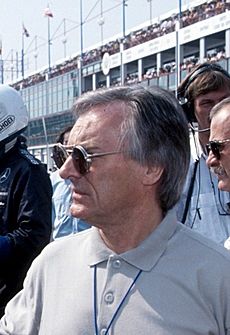
Since the 1970s, Bernie Ecclestone, who owned the Brabham team, gained control of the Formula One Constructors' Association (FOCA). He made better deals for the teams, including getting control of TV rights. The sport's main governing body, the Fédération Internationale de l'Automobile (FIA), saw FOCA's growing power. So, they put Jean-Marie Balestre in charge of a new group called FISA. FISA was given the job of managing Formula One's rules.
A big fight started between FOCA and FISA, especially between Ecclestone and Balestre. This fight is known as the FISA–FOCA war. FOCA included most of the British teams. FISA was supported by the big car manufacturers like Renault and Ferrari.
The conflict became very serious at the 1980 Spanish Grand Prix. Drivers from FOCA teams refused to attend a meeting. FISA threatened to take away their racing licenses. The race went ahead without the non-FOCA teams.
In 1981, FOCA and FISA signed an agreement called the Concorde Agreement. This agreement made sure all teams would attend all races. It also helped settle disagreements about future rule changes.
Rule Changes and Car Design
New Sporting Rules
For 1982, more cars were allowed to enter a Grand Prix, from 30 to 34. The number of cars that could start a race increased from 24 to 26. To manage this, a pre-qualifying session was added. The teams with the worst results from the previous year had to compete in this session. Only the best eleven results from all races counted for the Drivers' Championship. But all races counted for the Constructors' Championship.
Car Technology and Safety
Before 1982, two major car developments changed Formula One: turbocharged engines and "ground effect". In 1977, Lotus introduced the "wing car," which used ground effect. This design used the "Venturi effect" to suck the car to the ground. This made cars much faster in corners. But it also made them more dangerous. So, in 1981, rules were made to limit ground effect.
For 1982, these rules were changed back. This meant cars could use ground effect more. Cars with ground effect needed very stiff suspensions. This caused drivers to be shaken around a lot. The high cornering speeds also put huge strain on drivers and car parts. This made cars prone to breaking. Cars would also bounce up and down, called "porpoising." This made them very hard to control. Drivers reported feeling dizzy and having blurry vision.
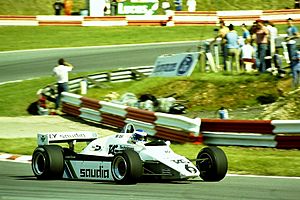
Powerful turbocharged engines also made things more dangerous. Renault introduced the first turbo engine in 1977. Rules allowed either large 3-liter normal engines or smaller 1.5-liter turbo engines. Turbo engines were fast but often broke down. They also had "turbo lag." This meant there was a delay between pressing the gas and the engine's full power kicking in. This made turbo cars very tricky to drive. Renault won the first race with a turbo engine in 1979. Ferrari also started using turbo engines in 1981. Toleman and Brabham also used turbo engines in 1982.
Most FOCA teams still used the older Cosworth DFV engine. These engines were less powerful than the turbos. To compete, these teams found a loophole in the rules. Cars were weighed before and after the race. Teams could add water tanks, claiming they were for cooling brakes. But they would dump the water during the race to make the car lighter and faster. Then, they would refill the tanks before the final weigh-in. Rosberg said this "gave us at least a theoretical chance to compete with the turbos."
Other rule changes included a slightly lower minimum weight for cars. A new "driver survival cell" was also made mandatory. This was a stronger cockpit area to protect drivers.
Four companies supplied tires: Goodyear, Michelin, Pirelli, and Avon. Special qualifying tires with extra grip were allowed again. But drivers were only allowed two sets of these tires per session. This made drivers take more risks to get a clear track for their fastest laps.
The 1982 Formula One Season in Detail
The 1982 season was full of drama, from strikes to tragic accidents and surprising winners.
Early Races and Driver Disputes
Before the first race in South Africa, drivers received a new "Super Licence" application. This new document said drivers couldn't switch teams easily. It also said they couldn't do anything that might "harm" Formula One. Niki Lauda and Didier Pironi (head of the Grand Prix Drivers' Association) were unhappy. They got other drivers to refuse to sign.
The drivers went on strike, refusing to practice. The conflict lasted two days. It ended with the drivers getting some promises. They were fined $5,000 each, but the new Super Licence rule was dropped. After this, the drivers' association changed its name.
When qualifying finally started, René Arnoux took pole position. In the race, Alain Prost won after a tire puncture forced him to pit. He then drove incredibly fast to win. Carlos Reutemann finished second, and Lauda was fourth in his comeback race.
The next race was in Brazil. Brabham switched back to their older, more reliable engines. Prost took pole position, much faster than the previous year. Nelson Piquet won the race, with Rosberg second. The race was very tough. Patrese retired from exhaustion, and Piquet fainted after the race. Ferrari and Renault protested Piquet and Rosberg's cars. They said the water tanks used by Brabham and Williams were illegal.
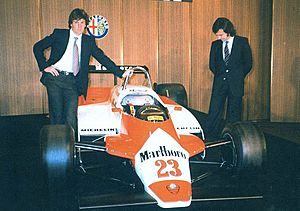
At the third race in Long Beach, Andrea de Cesaris surprisingly took pole position for Alfa Romeo. Lauda won the race, his first victory since returning. Villeneuve was later disqualified for using an illegal double rear wing.
European Races and Tragedies
Before the San Marino Grand Prix, the court ruled against Piquet and Rosberg. They were disqualified from the Brazilian race. Prost was given the win. The rules were changed so cars would be weighed after the race as they finished. This stopped teams from using the water tanks trick. Most FOCA teams boycotted the San Marino race in protest.
Only 14 cars raced at San Marino. The turbocharged Renaults and Ferraris were expected to win. Arnoux took pole. Ferrari drivers Villeneuve and Pironi were told to save fuel. Arnoux retired, leaving the two Ferraris to fight for the win. Pironi seemed to ignore team orders and passed Villeneuve multiple times. Pironi won, and Villeneuve was furious, saying he would never speak to Pironi again.
Two weeks later, at the Belgian Grand Prix, tragedy struck. During qualifying, Gilles Villeneuve crashed while trying to beat Pironi's time. He collided with Jochen Mass and was thrown from his car. Villeneuve died that evening from a broken neck. Ferrari withdrew from the race. John Watson won the race.
The next race was the Monaco Grand Prix. It was a sad race because Villeneuve had lived there. Ferrari raced with only one car. Arnoux led early but spun off. Prost took the lead but crashed in the rain. Patrese then took the lead but spun and stalled. Pironi and de Cesaris then ran out of fuel on the last lap. Patrese restarted his car and won his first race! Pironi was still classified second.
North American Races

The first Detroit Grand Prix was next. The track wasn't ready, causing delays. Prost took pole. The defending champion, Piquet, surprisingly failed to qualify. In the race, Prost led until his fuel injection had problems. Rosberg took the lead, but then had gearbox issues. Watson, who started 17th, drove brilliantly to win.
More tragedy hit at the Canadian Grand Prix. Pironi stalled on pole. His car was hit by Riccardo Paletti's Osella. Paletti, in only his second F1 race, suffered serious injuries and died. The race was restarted. Piquet won, followed by his teammate Patrese. Watson finished third, keeping his lead in the championship.
Back to Europe
At the Dutch Grand Prix, Patrick Tambay replaced Villeneuve for Ferrari. Pironi won the race. Arnoux had a big crash but was okay.
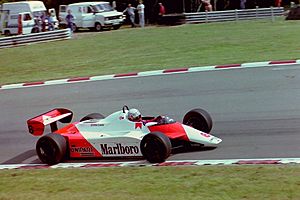
For the British Grand Prix, Brabham tried a new strategy. They started with half-full tanks and softer tires. They planned to pit halfway for fuel and new tires. Rosberg took a surprise pole position. But his car stalled at the start. Patrese also stalled and was hit by two other cars. Piquet retired, leaving Lauda to win his second race of the season. Pironi took over the championship lead.
At the French Grand Prix, the Renaults were very fast. Arnoux took pole ahead of Prost. Arnoux won, even though the team wanted Prost to win. Another big accident happened when Mass crashed into Baldi. Mass's car went into the stands. Luckily, no one was seriously hurt. Pironi now led the championship by nine points.
At the German Grand Prix, Pironi crashed in wet qualifying. He suffered severe leg injuries and could not race again. The race started with an empty pole position. Tambay won for Ferrari, his first Grand Prix victory. Rosberg finished third, moving up in the championship.
At the Austrian Grand Prix, most turbo cars retired. Prost was leading but retired five laps from the end. This left Elio de Angelis and Rosberg to fight for the win. De Angelis won his first Grand Prix by a tiny margin.
Rosberg then got his first win at the Swiss Grand Prix. He started behind the Renaults but drove consistently fast. He passed Arnoux and Prost to take the lead and win the race. This victory also put him in the lead of the championship.
At the Italian Grand Prix, Mario Andretti returned for Ferrari and took pole. Arnoux won the race. Rosberg didn't score points. Watson finished fourth, keeping his slim chance at the title alive.
Final Race and Championship Decided
The last race was the Caesars Palace Grand Prix in Las Vegas. Prost took pole. The race was very hot. Prost struggled with blistering tires and finished fourth. Michele Alboreto took a surprising win for Tyrrell. Watson finished second. Rosberg's fifth-place finish was enough to secure the championship! He became the first driver since Mike Hawthorn in 1958 to win the title with only one race victory.
After the Season
The 1982 season was the last for Lotus team owner Colin Chapman, who sadly passed away. After a season full of tragedy and excitement, FISA banned "ground effect" for 1983. This was done to make the cars safer. The 1982 season was remarkable for having 11 different winners in 16 races. Five drivers won their first ever Grand Prix: Patrese, Tambay, de Angelis, Rosberg, and Alboreto.
Race Results and Standings
Grand Prix Winners


How Points Were Scored
Points were given to the top six drivers in each race. For the Drivers' Championship, only a driver's best eleven race results counted. For the Constructors' Championship, all races counted.
| Position | 1st | 2nd | 3rd | 4th | 5th | 6th |
|---|---|---|---|---|---|---|
| Points | 9 | 6 | 4 | 3 | 2 | 1 |
World Drivers' Championship Standings
|
|
|||||||||||||||||||||||||||||||||||||||||||||||||||||||||||||||||||||||||||||||||||||||||||||||||||||||||||||||||||||||||||||||||||||||||||||||||||||||||||||||||||||||||||||||||||||||||||||||||||||||||||||||||||||||||||||||||||||||||||||||||||||||||||||||||||||||||||||||||||||||||||||||||||||||||||||||||||||||||||||||||||||||||||||||||||||||||||||||||||||||||||||||||||||||||||||||||||||||||||||||||||||||||||||||||||||||||||||||||||||||||||||||||||||||||||||||||||||||||||||||||||||||||||||||||||||||||||||||||||||||||||||||||||||||||||||||||||||||||||||||||||||||||||||||||||||||||||||||||||||||||||||||||||||||||||||||||||||||||||||||||||||||||||||||||||||||||||||||||||||||||||||||||||||||||||||||||||||||||||||||||||||||||||||||||||||||||||||||||||||||||||||||||||||||||||||||||||||||||||||||||||||||||||||||||||||||||||||||||||||||||||||||
World Constructors' Championship Standings
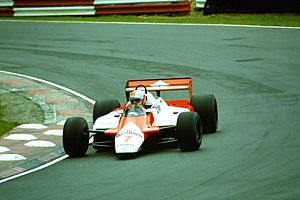
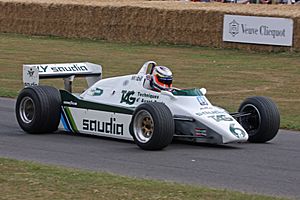
| Pos | Manufacturer | RSA |
BRA |
USW |
SMR |
BEL |
MON |
DET |
CAN |
NED |
GBR |
FRA |
GER |
AUT |
SUI |
ITA |
CPL |
Points |
|---|---|---|---|---|---|---|---|---|---|---|---|---|---|---|---|---|---|---|
| 1 | Ret | Ret | DSQ | 2 | DNS | 8 | 3 | 4 | 1 | 4 | DNS | 2 | DNS | 74 | ||||
| 18 | 6 | Ret | 1F | DNS | 2 | 3 | 9PF | 1 | 2 | 3 | DNSP | 3P | Ret | |||||
| 2 | 6 | 2 | 6 | 1F | Ret | 1 | 3 | 9 | Ret | Ret | Ret | 9 | 13 | 4 | 2 | 69 | ||
| 4 | Ret | 1F | DSQ | Ret | Ret | Ret | 4 | 1 | 8 | DNS | 5 | 3 | Ret | Ret | ||||
| 3 | 1F | 1PF | Ret | Ret | RetP | 7 | NCPF | Ret | Ret | 6 | 2 | Ret | 8 | 2PF | Ret | 4P | 62 | |
| 3P | Ret | Ret | RetP | Ret | RetP | 10 | Ret | RetP | Ret | 1P | 2 | Ret | 16 | 1F | Ret | |||
| 4 | 2 | Ret | Ret | Ret | 6 | 5 | 7 | 5 | 5 | 7 | Ret | Ret | 9 | Ret | 6 | 58 | ||
| 5 | DSQ | 2 | 2 | Ret | 4 | Ret | 3 | RetP | 5 | 3 | 2 | 1 | 8 | 5 | ||||
| 5 | 8 | Ret | 5 | 4 | 5 | Ret | 4 | Ret | 4 | Ret | Ret | 1 | 6 | Ret | Ret | 30 | ||
| Ret | 3 | 7 | Ret | 4 | Ret | Ret | DNQ | Ret | 12 | 9 | Ret | 8 | 7 | Ret | ||||
| 6 | 7 | 4 | 4 | 3 | Ret | 10 | Ret | Ret | 7 | Ret | 6 | 4 | Ret | 7 | 5 | 1F | 25 | |
| 16 | 7 | 10 | Ret | Ret | 8 | 9 | NC | Ret | 8F | 10 | 7 | Ret | 11 | Ret | 8 | |||
| 7 | Ret | 5 | Ret | DNQ | 1 | 2 | Ret | Ret | RetF | RetPF | 4 | Ret | Ret | 22 | ||||
| Ret | Ret | 15 | Ret | RetF | Ret | Ret | 5 | Ret | Ret | |||||||||
| 8 | Ret | Ret | Ret | 3 | Ret | 2 | 10 | DNQ | Ret | 16 | Ret | Ret | Ret | 6 | 3 | 20 | ||
| Ret | Ret | Ret | 9 | Ret | 6 | Ret | Ret | Ret | 14 | Ret | 3 | Ret | Ret | Ret | ||||
| 9 | DSQ | Ret | 19 | |||||||||||||||
| Ret | 3 | 1F | Ret | 2 | ||||||||||||||
| 10 | 13 | Ret | RetP | Ret | Ret | 3 | Ret | 6 | Ret | Ret | Ret | Ret | Ret | 10 | 10 | 9 | 7 | |
| 11 | Ret | Ret | Ret | Ret | Ret | Ret | Ret | 11 | 7 | 9 | 5 | Ret | 12 | Ret | 10 | |||
| 11 | DNQ | DNQ | Ret | 7 | 9 | 8 | 5 | 10 | Ret | 13 | 6 | Ret | 15 | Ret | 7 | 5 | ||
| DNQ | 10 | DNQ | Ret | DNQ | Ret | 8 | 6 | 9 | Ret | Ret | 6 | DNQ | 12 | 11 | ||||
| 12 | 10 | 5 | Ret | DSQ | Ret | Ret | Ret | DNQ | 12 | DNQ | 11 | Ret | Ret | Ret | DNQ | NC | 4 | |
| 9 | Ret | Ret | 5 | Ret | Ret | Ret | Ret | 13 | DNQ | Ret | Ret | DNQ | 14 | 9 | DNQ | |||
| 13 | Ret | 9 | Ret | 4 | Ret | DNQ | Ret | Ret | 14 | Ret | Ret | Ret | DNQ | Ret | Ret | DNS | 3 | |
| DNQ | DNPQ | DNQ | Ret | DNPQ | DNPQ | DNS | Ret | |||||||||||
| 14 | 17 | Ret | DNQ | 6 | DNPQ | 11 | DNQ | Ret | Ret | DNQ | 11 | 7 | DNQ | 11 | DNQ | 1 | ||
| — | 12 | 8 | 8 | Ret | DNQ | 7 | 11 | Ret | 10 | Ret | DNQ | Ret | Ret | DNQ | 12 | 0 | ||
| 15 | Ret | 9 | 8 | DNPQ | Ret | Ret | Ret | DNQ | DNQ | Ret | DNQ | Ret | DNQ | 13 | ||||
| DNPQ | DNPQ | DNQ | DNQ | DNPQ | ||||||||||||||
| — | WD | DNQ | Ret | DNQ | DNQ | Ret | Ret | DNQ | Ret | DNQ | 8 | Ret | Ret | NC | DNS | 0 | ||
| — | Ret | DNQ | DNPQ | Ret | Ret | DNQ | RetF | Ret | 15 | 10 | Ret | Ret | Ret | Ret | 0 | |||
| DNQ | DNQ | DNQ | NC | Ret | DNPQ | DNQ | Ret | Ret | DNQ | Ret | Ret | Ret | DNQ | |||||
| — | 14 | Ret | Ret | DNQ | DNQ | DNQ | Ret | Ret | DNQ | DNQ | DNQ | Ret | DNQ | DNQ | Ret | 0 | ||
| Pos | Manufacturer | RSA |
BRA |
USW |
SMR |
BEL |
MON |
DET |
CAN |
NED |
GBR |
FRA |
GER |
AUT |
SUI |
ITA |
CPL |
Points |
| Source: | ||||||||||||||||||
|
See also
 In Spanish: Temporada 1982 de Fórmula 1 para niños
In Spanish: Temporada 1982 de Fórmula 1 para niños


